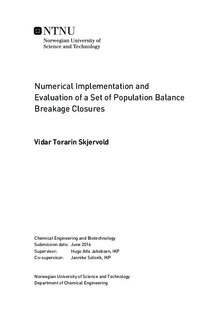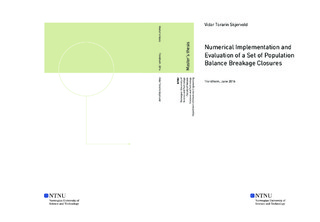| dc.description.abstract | The population balance equation (PBE) can be used to model multiphase processes, where
one or more dispersed phases are distributed in a continuous medium. In such systems,
the interfacial area is an important quantity, because it governs the rate of mass, heat and momentum transfer between the phases. Applying the PBE to multiphase systems gives a more accurate description of the interfacial area, and is therefore an important tool in the modelling of several types of chemical engineering equipment. In order to solve the PBE, constitutive equations known as breakage closures must be specified. Without accurate and robust breakage closures, it is difficult to accurately predict the size distributions in multiphase processes using the PBE.
Despite the considerable efforts that have been invested in developing breakage closures, there does not seem to be consensus in the literature on the underlying physics of the breakage mechanism. The objective of this thesis was to perform an evaluation of a set of breakage closures, to determine their suitability as constitutive equations in the population balance equation. Emphasis was placed on selecting regularly used closures that were designed for turbulent systems. The closures were evaluated with regard to computational time, conserving properties, the ability to reproduce experimental data and their performance as closures in a simplified PBE test case. All closures were extended to the wide energy spectrum of turbulence, and the extended models were also included in the evaluation.
Based on the evaluation, it was concluded that the models of Coulaloglou and Tavlarides (1977), Han et al. (2011) and Becker et al. (2014) were most suitable as constitutive equations in the PBE. Additionally, a modified version of Martınez-Bazan et al., where a breakage probability was introduced to make the breakage frequency profile less steep, performed well. These closures were computationally efficient, volume and number conserving, in acceptable agreement with at least one of the experimental data series and gave plausible solutions of the PBE test case without causing numerical difficulties. To Ensure that the breakage closures are valid in all ranges of turbulence, the wide energy spectrum versions should be used. The capillary criterion was identified as an important breakage constraint, because it avoids accumulation of particles at the smallest particle size in the mass density function.
All of the studied closures apply a priori assumptions of the number of daughters formed in the breakage process. Introducing a relation that calculates the number of produced daughters based on the system properties and mother particle size was identified as a possible way of improving the breakage closures. However, introducing such a relation involves some challenges, and a method for reducing the model complexity by dividing the daughter population into groups based on the particle size was presented. When applying this method, care should be taken to ensure that the redistribution density function is both volume and number conserving. New breakage closures based on this concept should be developed and evaluated, to determine if the prediction of the number of daughters makes the models more physically realistic.
In the literature, there is a general lack of experimental data for the breakage frequencies and probability density functions for bubbles and droplets. In order to enable proper evaluation of the breakage closures, it should be made a priority to perform experiments on the breakage frequencies and redistribution functions for both bubbles and droplets in several systems for a wide range of particle sizes. | |

